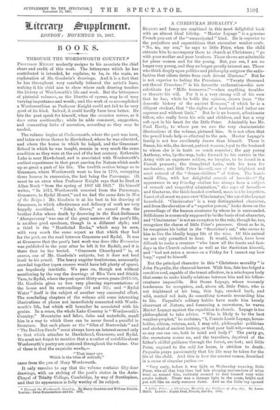BOOKS.
THROUGH THE WORDSWORTH COUNTRY.* PROFESSOR KNIGIIT modestly assigns to his associate the chief share and credit of this work. The letterpress which he has contributed is intended, he explains, to be, in the main, an explanation of Mr. Goodwin's drawings. And it is a fact that he has throughout -very carefully followed the artist's lines, making it his chief aim to show where each drawing touches the history of Wordsworth's life and work. But the letterpress of pictorial volumes, as the libretto of operas, may be of very varying importance and worth ; and the work of so accomplished a Wordsworthian as Professor Knight could not fail to be very good of its kind. Indeed, it could hardly have been better. He lets the poet speak for himself, when the occasion serves, as it does servo continually; while he adds comment, suggestion, and connecting links of narrative, according as they may be needed.
The volume begins at Cockermouth, where the poet was born, and takes us from thence to Hawkshead, where he was educated, and where the house in which he lodged, and the Grammar- School in which he was taught, remain in very much the same condition as they were at the end of the last century. Esthwaite Lake is near Hawkshead, and is associated with Wordsworth's earliest experiences in that great passion for Nature which made up so great a part of his life. The twelfth section brings us to Grasmere, where Wordsworth went to live in 1799, occupying three houses in succession, the last being the Parsonage. (It must be an error when Professor Knight says that he lived at Allan Bank " from the spring of 1807 till 1821." He himself writes, " In 1813, Wordsworth removed from the Parsonage, Grasmere, to Rydal Mount," and we find the same date in Mess of the Reign) Mr. Goodwin is at his best in his drawing of Grasmere, in which effectiveness and delicacy of work are very happily combined. "John's Grove," so named from the brother John whose death by drowning in the East-Indiaman Abergavenny ' was one of the great sorrows of the poet's life, is another good specimen, though in a different style; and a third is the " Heathclad Rocks," which may be seen, with very much the same aspect as that which they had for the poet, on the road between Grasmere and Rydal. It was at Grasmere that the poet's best work was done (the Excursion was published in the year after he left it for Rydal), and it is there that he lies buried. " Grasmere Churchyard" is, of course, one of Mr. Goodwin's subjects, but it does not lend itself to his pencil. The heavy angular tombstones, necessarily crowded together (open crosses would have left plenty of space), are hopelessly inartistic. We pass on, though not without mentioning by the way the drawings of Blea Tarn and Stickle Tarn, to Rydal, where the poet spent thirty-seven years (1813-50). Mr. Goodwin gives us two very pleasing representations of the house and its surroundings (34 and 35); and " Rydal Water" itself is the subject of another very successful effort. The concluding chapters of the volume add some interesting illustrations of places not immediately connected with Words- worth's life, but which will hereafter be associated with his genius. In a sense, the whole Lake Country is " Wordsworth's Country." Mountains and lakes, dales and waterfalls, recall him in a way to which there can be never found a parallel in literature. But such places as the " Glen of Borrowdale" and "The Duddou Sands " must always have an interest second only to that which attaches to Hawkshead, Grasmere, and Rydal. We must not forget to mention that a number of notabilia about Wordsworth's poetry are scattered throughout the volume. One of these is that the exquisite words,— " That inner eye Which is the blies of eolitude," came from the pen of Mary Wordsworth.
It only remains to say that the volume contains fifty-four drawings, with an etching of the poet's statue in the Ante- Chapel of Trinity College, Cambridge, by way of frontispiece, and that its appearance is fully worthy of its subject.
s Through the Wordsworth Country. By Harry Goodwin and Willis,,, Knight. London: Swan Sonnestachain and Co. 1887.























































 Previous page
Previous page